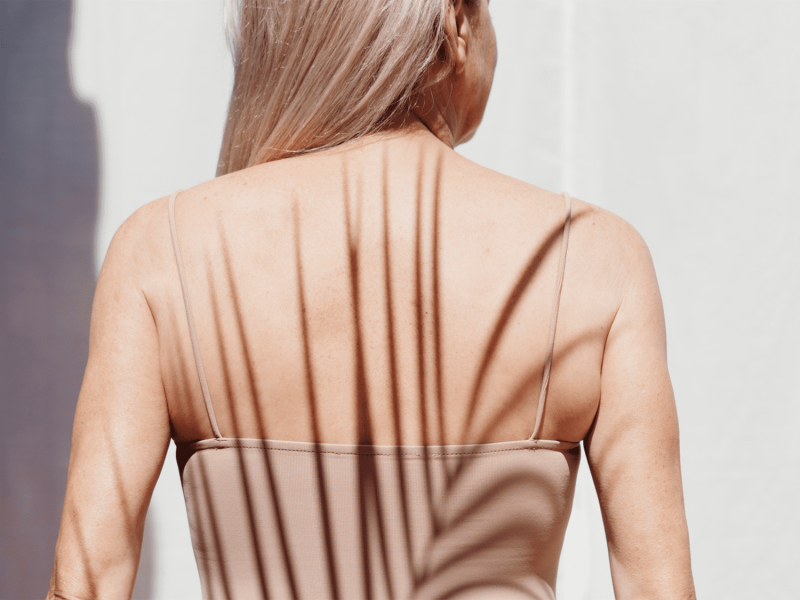
Potential Side Effects The Cost Aftercare The Final Takeaway
Is there anything Botox can’t do? It’s FDA-approved to smooth wrinkles and lines, stop excessive underarm sweating and prevent migraines. And its off-label uses are plentiful, too. Chances are, you’ve caught a viral TikTok video or two singing the praises of “TrapTox.” The buzzy treatment involves injecting Botox into the trapezius (trap) muscles to create a longer, leaner neck and better-defined shoulders.
Injecting these large muscles (the muscle group runs from the base of the neck across the shoulders and down the upper part of the back) with Botox helps them to relax and, in turn, improve posture, neck and shoulder stiffness, and pain, and create more of a contoured and elongated neck. Ahead, two dermatologists break down everything you need to know about TrapTox.
What Is Trapezius Botox?
Even though trapezius Botox may be trending, Dr. Amy Wechsler says Botox has been used for years to relax overused muscles. The trapezius muscles, essential for daily movement, stabilize the neck and shoulders for good posture. But they can become inflamed and enlarged from certain weightlifting exercises, reaching overhead, poor sleeping positions and posture, and sitting hunched over. "Treating the trap muscles with Botox can create a longer-looking neck if it is overworked and looks shortened," Dr. Wechsler adds.
Dr. Macrene Alexiades says treating the trapezius muscles with Botox also relieves muscle contractions and shrinks the muscle. "Using Botox on the traps has proven effective for unforgiving muscle knots and chronic migraines," she notes.
The Benefits of Trapezius Botox
- Relaxes the trapezius muscles
- Reduces pain and stiffness
- Alleviates excessive muscle contraction
- Makes the neck and shoulder look elongated and lean
Dr. Wechsler says pain relief from the partial relaxation of overused muscles is the most significant benefit of the treatment. Many people hold tension in the trapezius muscles, which causes shoulder pain and stiffness. Injecting the large trapezius muscle group with Botox, or any other neuromodulator, releases tension in the area and recurring tension headaches and tech neck.
From an aesthetic standpoint, TrapTox can create an elongated neck and leaner-looking shoulders. Dr. Macrene says Botox relaxes and partially inactivates the injected muscles, causing them to lose size and volume. “Injecting the trap muscles with Botox can also alleviate excessive muscle contraction, releasing them so that the front and back of the upper body are more balanced to improve posture. Botox has been clinically proven with a statistically significant difference in thicknesses to reduce trapezius hypertrophy.”
Does Trapezius Botox Hurt?
Injecting Botox into the trap muscles hurts no more than injecting Botox into the face or elsewhere on the body. There will be a slight pricking sensation with each injection as the needle pierces the skin. But other than that, there's little discomfort or pain during the treatment or afterward. Your dermatologist can apply topical numbing cream before the injections to make the treatment more comfortable.
How to Prepare for Trapezius Botox
Prep work for trapezius Botox follows the same protocol as any other Botox treatment. While there's no major prepping, there are a few do's and don'ts to follow in the days leading up to the injections to make the treatment more effective. For starters, try and relax the muscles as much as possible to reduce stress and tension in the area. Dr. Macrene says to avoid exercising for at least two hours before TrapTox and refrain from workouts for the rest of the day.
Additionally, our experts recommend avoiding drinking alcohol for up to one week before the injections since it can cause the area to bruise and swell. You'll also want to avoid taking blood thinners for a week and aspirin or other anti-inflammatory medications a few days before your Botox appointment since they can increase the risk of bleeding.
What to Expect
Even though different types of neuromodulators are available at your dermatologist's office, including Botox, Dysport, Jeuveau, Xeomin, and Daxiffy, Dr. Wechsler says one specific brand doesn't necessarily work better for treating the trapezius muscles than another, so stick with the one you feel most comfortable with.
Trapezius Botox is a quick and easy procedure that takes 10 to 20 minutes. On average, 50 units of Botox are injected into the left and right trapezius muscles, but some people need more depending on their muscles' size. "Every person should be evaluated on a case-by-case basis to ensure they have a curated treatment approach," Dr. Macrene suggests.
First, your dermatologist will mark the areas to inject along the shoulder. Then, they will quickly inject the Botox into each area. The nice thing about TrapTox is that there's no downtime, but the results take time to develop. Dr. Weschler says they can usually be seen two to three days after the injections and kick in over two weeks. Once the Botox starts to weaken the muscle, you'll feel less tightness and pain in the shoulders, neck, and back and have a greater range of motion. On average, the results last four months, although some may notice the effects lasting an extra month or so.
Potential Side Effects
Trapezius Botox is a relatively uncomplicated treatment, and the potential side effects are rare yet the same as what you could experience with Botox injections for wrinkles and lines. Post-injection, redness and mild swelling and bruising are common. Additionally, if the toxin is injected inappropriately, there may be a diffusion effect, which can cause flu-like symptoms and muscle weakness. "That's why your injector must be skilled and experienced in injecting those muscles to reduce the potential for unwanted side effects," Dr. Wechsler says.
It can also be difficult and take far more effort to extend the neck and shrug the shoulders due to muscle weakness, but this movement will slowly be regained when the Botox starts to wear off.
The Cost
You can expect to pay anywhere from $10 to $25 per unit, which comes out to somewhere between $500 to $1000 per session, or more, depending on how many units of Botox you'll need. Unless your doctor deems your Botox treatment medically necessary, which you'll have to prove through examination and diagnosis, chances are your health insurance won't cover the cost.
Aftercare
Your dermatologist will have you follow the same post-Botox protocol for your trap muscles as you do for your face, which includes no working out—especially anything strenuous—or laying down for eight hours. Dr. Macrene says to lay off drinking any alcohol for the first 24 hours and avoid hot baths and saunas post-treatment, which might cause a spike in body temperature and impede the results.
Mild redness and soreness are typical after a TrapTox session. If that happens, icing the area can help dull any discomfort. It's also worth noting that sitting up without slouching and walking straight without hunching over is important. Failing to practice good posture can cause the trap muscles to bulk back up fast.
The Final Takeaway
Dermatologists are seeing an uptick in patients requesting trapezius Botox, and for a good reason: it helps reduce tension-related pain while creating a more contoured look around your neck and shoulders. Like Botox injections for the face, the results of TrapTox take a few days to a few weeks to fully take hold, but they don't last forever. If you want to ensure the effects hold up, you'll need to visit your dermatologist about two to three times annually.

